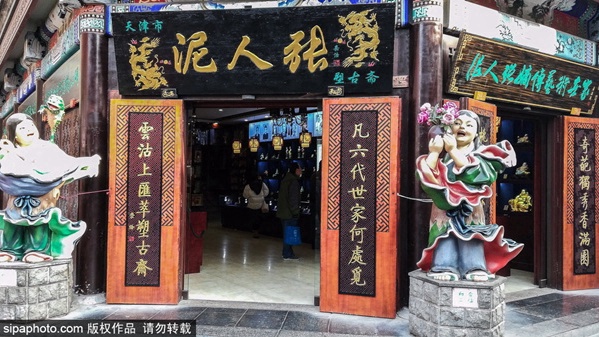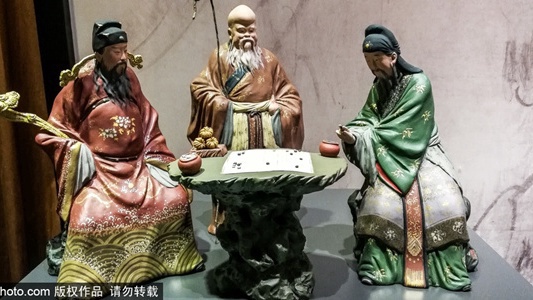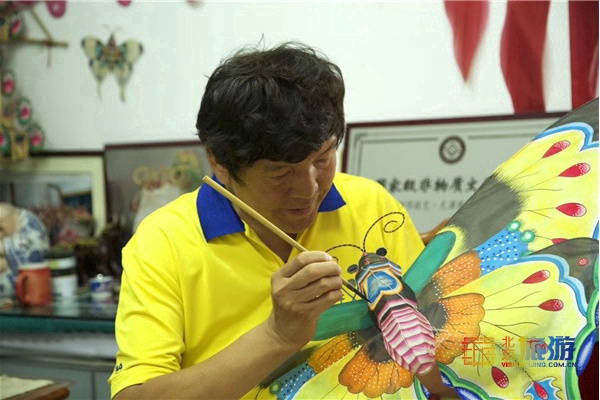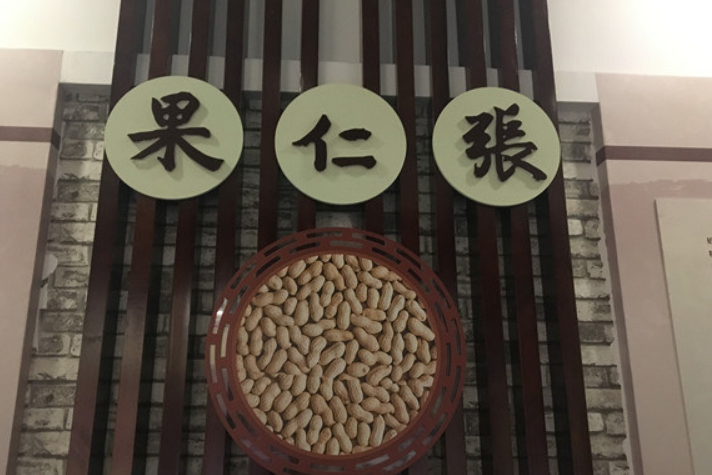As one of the ten scenic spots in Tianjin, Tianjin Ancient Cultural Street has always insisted on “Flavour of China and Tianjin, sense of culture and history”. The existing Ancient Cultural Street include Tianhou Temple and Gongnan and Gongbei Streets, which are 580m long and 7m wide. Most of the buildings here are designed as the small folk buildings in the Qing Dynasty. There are nearly a hundred time-honoured brands along the street, mainly dealing in cultural products, antique books, folk products, and traditional handicrafts. The famous Clay Figurine Zhang, Kite Wei, Nut-kernel Zhang, etc. have set up special shops here. When you come to Tianjin, this street must be on your list!
Tianhou Temple

Tianhou Palace was built in 1326 (the third year of Taiding in Yuan Dynasty). It was originally named Tianfei Temple, commonly known as Niangniang Temple. It has been rebuilt many times, and is the oldest building complex in Tianjin city and one of the earliest Mazu temples in China. The building complex faces the Haihe River in the east. It is composed of gates, archways, front halls, and main halls, and is a typical Chinese traditional temple-style building. Every year on the birthday of the Queen of Heaven, a large-scale folk rewarding temple event is held with Tianhou Temple as the centre site. Boat owners along the river and surrounding followers also come one after another. Merchants from all over the world gather, creating the prosperity of Tianjin’s most famous commercial street - Gongnan Gongbei Street (now ancient culture Street).
In the past, ship owners often made models of ships and presented them to the Queen before sailing out to sea, praying for a safe journey. Local Tianjin people also have the custom of praying for children in Tianhou Palace. The traditional cross talk “Tie the Doll” just tells this custom. In the past, married couples who had no children would go to Tianhou Temple to worship and tie a clay doll with a red thread to go home for further worship. Such doll is called “Elder Brother Doll”, which is their eldest son. Even if they give birth to the “real” eldest son in the future, he will still be the second child. Every year, people also take the doll for a “bath”, which means it grow up a little every year, and this is also one of the folk beliefs of old Tianjin.
The incense in Tianhou Temple is very prosperous, especially on the 23rd of the lunar calendar, which is the birthday of Tianhou. During this time every year, the “imperial party” is held, with performances of stilts, dragon lanterns, dry boats, and lion dances. Everything creates a lively atmosphere. Tianhou Palace has now become the Tianjin Folk Museum, introducing the historical evolution of Tianjin and displaying various folk customs.
Address: No. 80, Guwenhua Street, Nankai District, Tianjin
Clay Figurine Zhang

This shop is very big, and just locates next to Tianhou Temple. Clay Figurine Zhang is quite unique in Tianjin, and many tourists will come and buy clay figurines.
The clay figurine Zhang Caishou in Tianjin is a kind of traditional folk art that is deeply loved by the people. It has been passed down and developed for 180 years. The coloured sculptures of clay figurines raise the traditional clay figurines to the level of round carvings, decorated with colours and props to form a unique style.

It is another peak of clay sculpture art in China after Liu Yuan in the Yuan Dynasty. Its works are exquisitely artistic, and its influence reaches far and wide in the world, occupying an important position in the history of traditional folk handicrafts in China.
Address: No. 11, Guwenhua Street, Nankai District, Tianjin
China Shoe Culture Museum
The China Shoe Culture Museum has an exhibition area of nearly 1,000㎡, displaying shoe exhibits from various periods such as ancient times, Shang and Zhou, Qin and Han, Tang, Song, Yuan, Ming and Qing, and the Republic of China. There are both ancient relics, late imitations, shoes in the past thousands of years are dispalyed clear at a glance. The exhibition is divided into 7 parts: shoe development history, footwear folklore, folk footwear, three-inch golden lotus, boutique exhibition, shoemaking skills, and scene restoration. It contains more than 60 topics related to shoes with thousands of exhibits.
Every shoe in the museum’s “Folk Culture Theme” represents the social etiquette and customs of a person’s life: birth, growth, marriage, courtship, birthday, filial piety and funeral. The footwear folklore and boutique exhibitions include Ping An Fu shoes, Dayu stone shoes, spice drawer shoes, step-by-step flower shoes, imperial examination cheating shoes, Qing palace dragon boots...Various shoes in different shapes make people feel like being in the world of shoes. In the museum’s “Folk Footwear Theme”, each pair of shoes reflects the Chinese nation’s production methods, living customs, religious etiquette, culture, art and aesthetic appeal.
Visitors can also experience shoe-making craftsmanship in specific areas.
Address: No. 166, Haihe Building, Ancient Cultural Street, Nankai District, Tianjin
Guifaxiang Eighteenth Street Fried Dough Twist

Guifaxiang Eighteenth Street Fried Dough Twist is a famous traditional snack. This century-old twist shop in Tianjin, together with Tianjin Goubuli steamed buns and Erduoyan fried cakes, is called “Tianjin’s Three Wonders”. Guifaxiang Eighteenth Street Fried Dough Twist was recognized as “Chinese Famous Snacks” at the first National Snacks Accreditation Conference. In 1996, it was named “Chinese Time-honored Brand” by the Ministry of Internal Trade of China. It has been recognized as a well-known trademark in China, a famous brand product and famous trademark in Tianjin.
Guifaxiang 18th Street Fried Dough Twisted Store was once located at the 18th Street of Dagu South Road. Thus, people used to call it 18th Street Fried Dough Twisted. When the 18th Street was renovated, a new Guifaxiang Dagu South Road store was built 200m away from the original site. Guifaxiang fried dough twists are made with sesame, peach kernel, melon seed kernel, green plum, sweet-scented osmanthus, and flavoured water. After the twists are formed, put them in a peanut oil pan and deep-fry them over a low fire. Then add sugar cubes and sprinkle with melon strips and other ingredients.
Address: No. 117, Gongnan West Street, Guwenhua Street, Nankai District, Tianjin
Kite Wei

Kite Wei has a history of hundreds of years. Its first generation was Wei Yuantai. Born in a poor family, Wei Yuantai worked as an apprentice in a paper art shop at the age of 16. Since then, he developed his keen interest in making kites. Wei Yuantai is ingenious and willing to work hard. During his apprenticeship, he was challenged by customers to make a kite that was ten feet long. With his intelligence, he really made a centipede kite that was ten feet long. At the end of his four-year apprenticeship, he learned the craft of paper art, kites and other small toys. His father helped him to start his own shop on Dongmenli Street. The shop was named “Changqingzhai”, and since then, he began his career of making kites. In addition to making paper arts in general, he also meticulously and repeatedly studied and observed the bodies of flying animals such as dragonflies, butterflies, eagles, swallows, the proportions of their wings, and their flying postures, and then he devoted himself to the details of kites. Every time he makes a kite, he has to sculpt it carefully, test and fly it repeatedly, and improve it step-by-step. After Wei Shenxing, the second-generation inheritor, and Wei Yongchang, the third-generation inheritor (who was awarded the title of Master of Arts and Crafts by UNESCO at the time), the fourth-generation heir Wei Guoqiu is now in charge.
The kite made by Wei Guoqiu looks realistic in shape and won the first place in the National Kite Competition in 1982. In 1983, he won the first prize of Tianjin International Kite Fair. In 1993, he participated in the Chinese Folk Art Fair and performed craft performances and won the first prize. In 1994, he’s work was selected as one of the best Chinese folk art. He was also awarded the title of “Folk Arts and Crafts Artist” by UNESCO. His kites can not only be flown, but also be appreciated. They are both practical and valuable for collection. His works are both traditional and modern, maintaining the characteristics of multiple shapes, life-like colour painting, excellent aerobatics and stable flying, and emphasizes traditional ethics and constant
Nut-kernel Zhang

Nut-kernel Zhang is a time-honoured brand in China. Its nut products have been created for more than 160 years and are one of Tianjin’s specialties.
Nut-kernel Zhang’s traditional products include amber peanut kernels, amber walnut kernels, tiger skin peanut kernels, pure fragrant peanut kernels, milk-flavoured melon seeds and five-spice pine nuts. Innovative products include amber cashew nuts, milk-flavored almonds, milk-flavoured, spiced, cocoa, spicy, seaweed, vanilla, orange, lemon, hawthorn, curry, mint, ginger juice and other flavours of peanuts, broad beans and green beans. In addition, it also operates the export business of other food and native products.
Nut-kernel Zhang’s foods are sweet, crisp, delicious, endless aftertaste, and long-term storage. It is well-known at home and abroad for its exquisite craftsmanship and unique flavour, and is known as “special in the food court”.
Address: About 50m southeast of the intersection of Tongbei Road and Da Hutong, Nankai District, Tianjin
innovation. The “gongs, drums and wild geese” he produced can even play beautiful music in the air. Kites such as “Flying Eagle”, “Dragon Eye Fish”, “Crab” and “Songhe Yannian” are his masterpieces.
The shop is not big, but is full of kites. Customers can not only buy ready-made kites, but also experience the fun of making kites here. It is very suitable for bringing children here.
Address: 4th Floor, New World Department Store, No.138 Dongma Road, Nankai District, Tianjin



